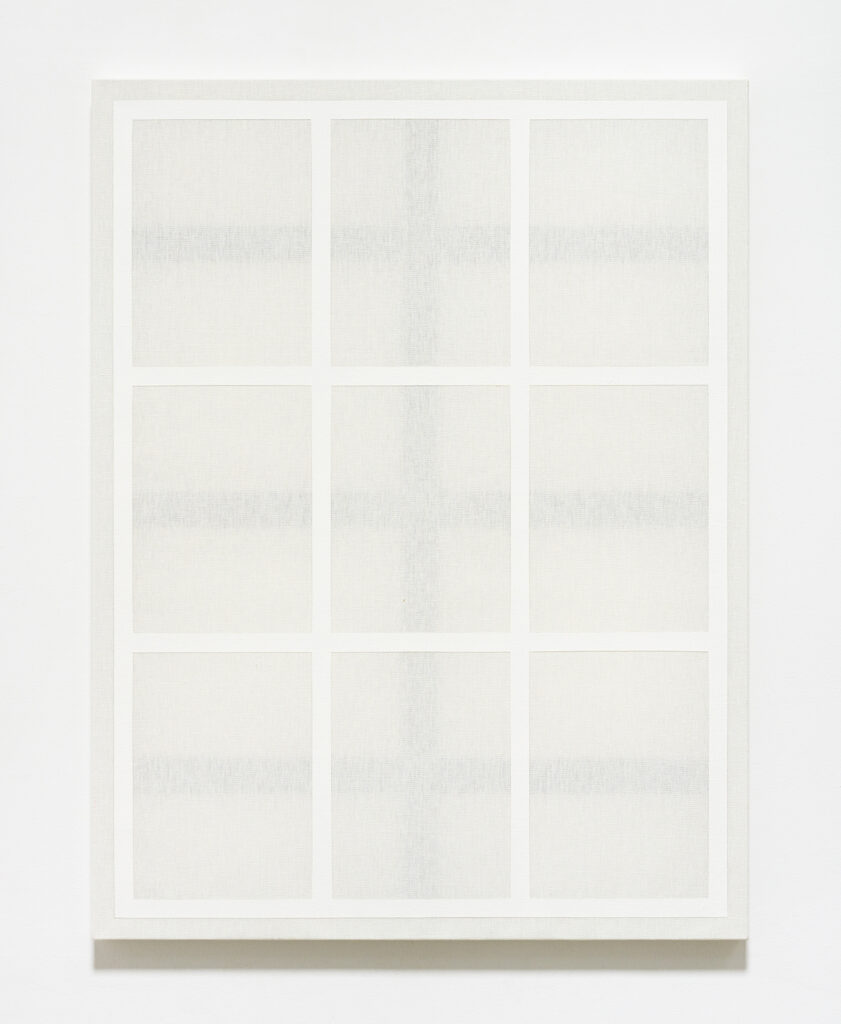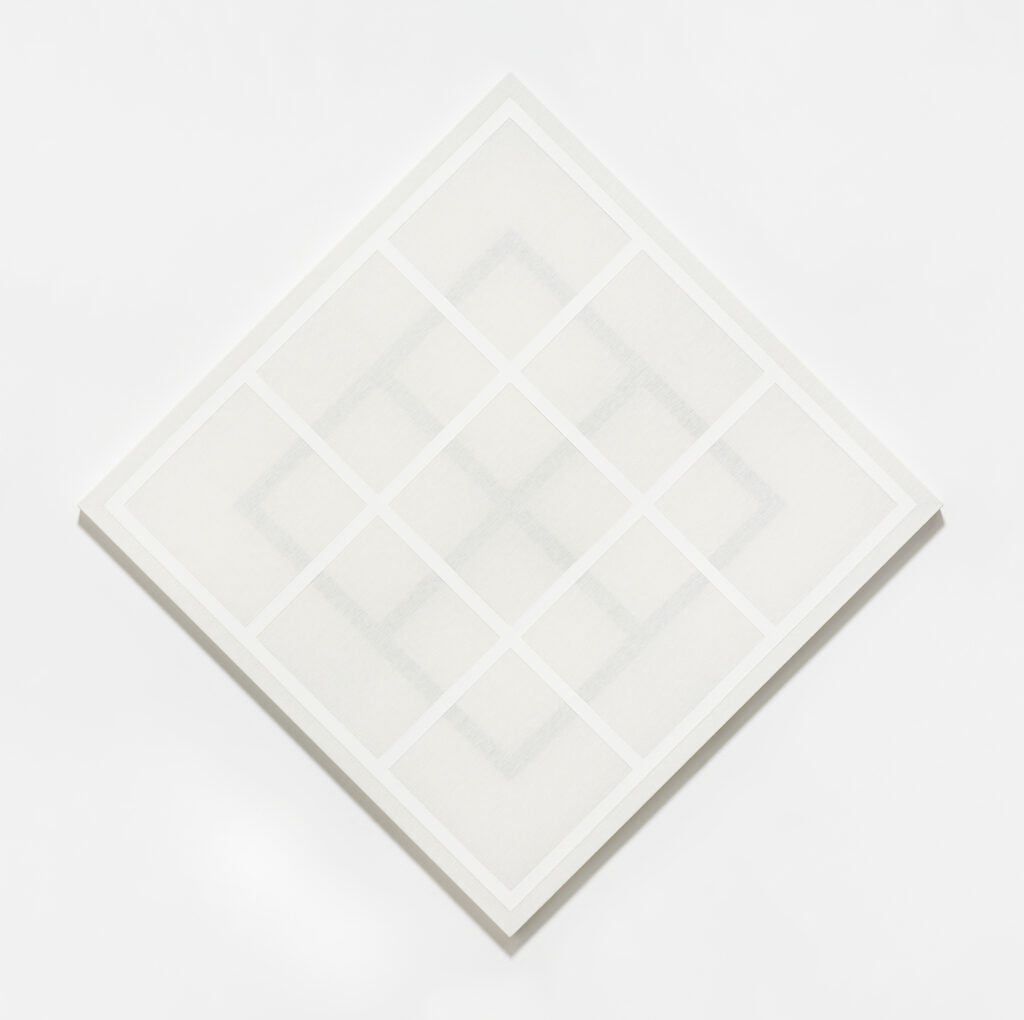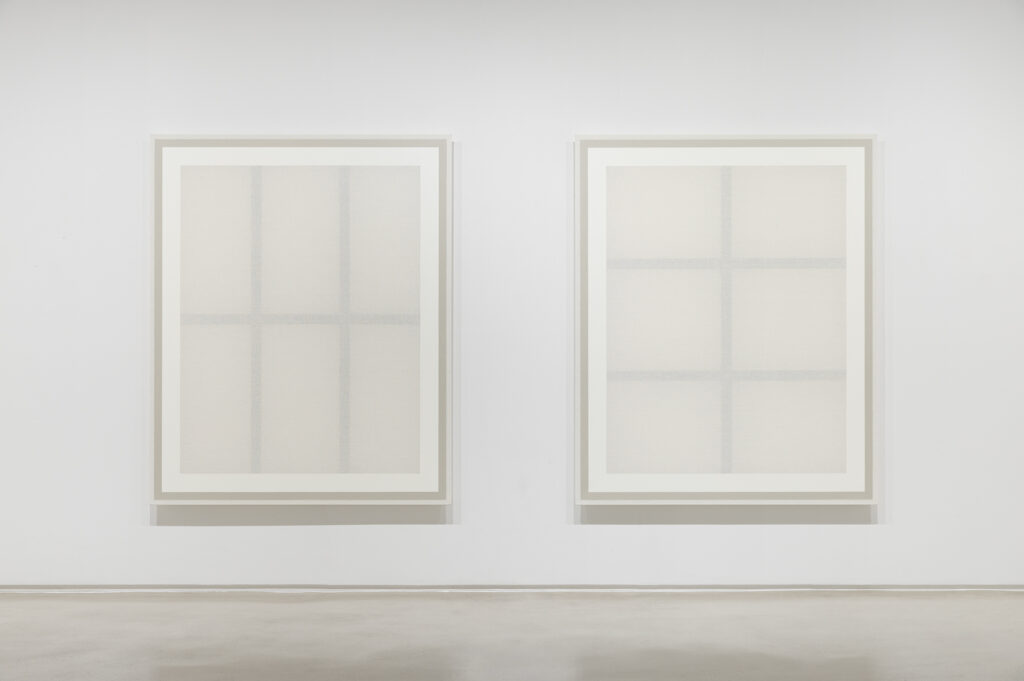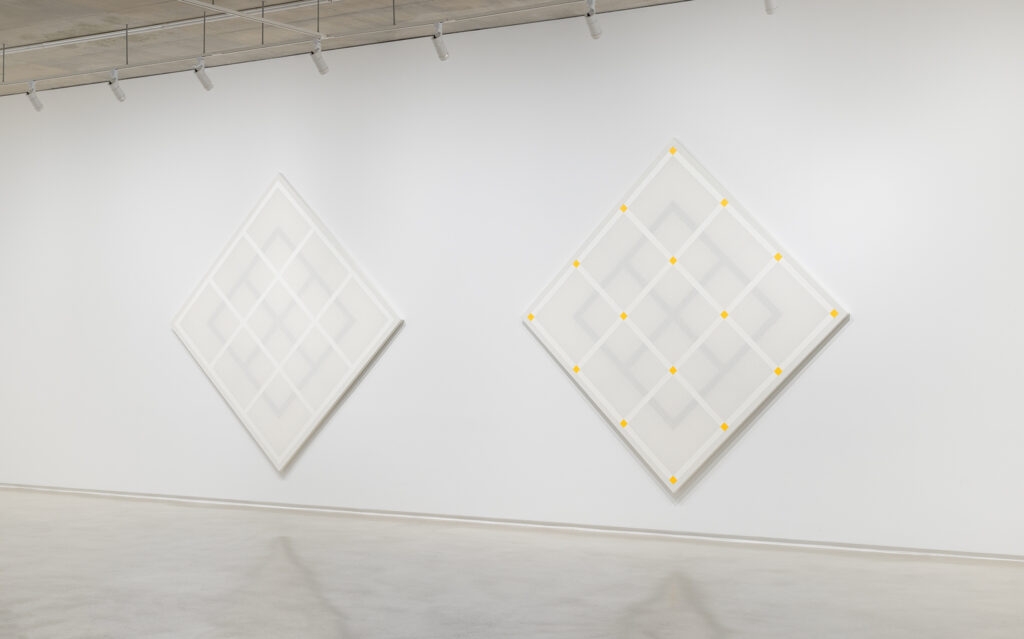

평일 (Weekday) : 11:00am~18:00pm
주말 (Weekend) : 11:00am~18:00pm
휴관일 (Closed days) : 일(Sun), 월(Mon)
절제된 색과 구조로 이뤄진 이교준의 정연한 작품들은 보는 이들로 하여금 단순하면서도 어려운 질문을 던진다. 회화의 평면성이란 무엇인가. 이교준은 이번 피비갤러리에서 발표하는 근작을 통해 우리가 회화로서 인식하던 범주를 벗어나도록 하며 평면에 대한 진중한 고찰을 이어가도록 제안한다. 근작은 언뜻 본다면 수평과 수직을 통한 이성적 면의 분할이 이뤄졌다는 점에서 기존의 작품과 크게 다르지 않아 보인다. 하지만 가만히 서서 그림을 들여다보면 그림이 그려진 캔버스 뒤로 비치는 새로운 분할의 형태를 발견할 수 있다. 작가는 보는 이의 시선이 캔버스를 지나 캔버스 너머의 공간까지 도달했다가 다시 되돌아올 수 있도록 올과 올 사이로 빛이 투과되는 성글게 직조된 천을 제작하여 사용하였다. 이때 캔버스를 지지하는 알루미늄 지지체의 구조가 평면 위에 그려진 분할과 겹쳐지며 새로운 분할의 형태와 공간을 제시한다.
홍익대학교 정연심 교수는 이교준에 대해서 “선과 선이 서로 그리드로 연결되어 있듯이, 그가 지난 50년 동안 경험한 매체는 서로의 관계성(relationality)을 이루고 있다.”고 언급한 바있다. 이처럼 회화의 평면성에 질문하고 평면 안에서 분할을 통해 새로운 공간을 발견하는 그의 일관적인 태도는 작업을 관통하고 연결시킨다. 1990년대 후반, 두꺼운 판화지를 접어 분할한 면을 평면 위에서 입체로 들어올리는 작업이 그 예증이다. 이교준은 회화의 주요한 정체성 중 하나로 인식되었던 매체를 통한 ‘그리는 행위’ 없이 2차원 평면 안에서 면을 구획하고, 선을 구축함으로써 3차원의 공간을 생성해냈다. 이 작업은 2007~2014년 캔버스 위로 면과 선으로 구성된 층을 겹치며 각 층이 공간을 내포하고 있는 ‘윈도우(Window)’ 시리즈, 2009~2012년 사각형 박스 안에 합판 조각을 겹겹이 쌓아 공간을 분할한 ‘보이드(Void)’ 시리즈로 이어지며 분할의 시각적, 물질적 입체화를 시도하기도 했다. 이렇듯 작가의 회화에 대한 근원적 질문과 고찰을 담은 작업은 오롯이 그의 다른 작업의 기반이 되며 이교준의 작품세계가 더욱 견고해질 수 있도록 만들었다.
“가장 단순한 것이 모든 걸 담을 수 있다”는 이교준의 평면과 분할에 대한 화두는 많은 이들에게 당연시되어지는 것들을 다시 한번 들여다보고, 이를 통해 본질에 대한 해답을 묵묵히 찾아가는 그의 수행자적 태도를 고스란히 담고 있다. 어쩌면 그의 말은 시시각각 정제없이 밀려오는 정보의 늪에서 갈피를 잃고 부유하는 현대사회의 우리에게 필요한 문장일 수도, 혹은 점점 더 빠른 속도로 새로운 것만을 찾고자 하는 현재의 미술계를 다시금 되돌아보는 기회가 될 수도 있을 것이다. 이교준 개인전 《Beyond the canvas》에서 수평선과 수직선을 교차해나가며 작가가 구축해온 회화의 영역 그리드(Grid) 그 너머에 대해 바라보고, 더 나아가 선명한 인식의 공간으로서 시각을 확장하는 기회가 되길 바란다.
한편, 이번 피비갤러리 이교준 개인전 전시기간 중에는 서울 곳곳에서 이교준 작가를 다각도에서 바라볼 수 있는 전시들이 함께 예정되어있다. 2024년 8월 29일부터 개막하는 서울시립미술아카이브 소장품 기획전에서는 서울시립미술아카이브에 소장된 이교준 컬렉션과 근작 회화가 함께 전시로 소개되어 작업의 근간을 이해할 수 있는 기회가 될 것이다. 또한 2024년 9월 2일부터 9일까지 키아프·프리즈 기간동안 피비갤러리와 갤러리 클립이 함께 이교준 작가의 주요 작업을 일목요연하게 소개하는 ‘Selected works’ 특별 전시가 북촌의 한옥 ‘호호재’에서 열린다. 호호재는 전통적 구조를 유지하고 있는 2층 모던 한옥으로, 그간 현대적 화이트 큐브에서 소개되어 온 이교준 작가의 작업을 한옥에서 발견할 수 있는 건축요소와 결합하여 작업 속에 내제된 한국의 비례와 균형의 미를 함께 조명해 보고자 한다.
PIBI Gallery presents Beyond the Canvas, the solo exhibition of Lee Kyojun from August 14th to September 28th, 2024. Renown for his geometric abstract paintings, Lee has ceaselessly delved into the essence of art via his creative realm for over fifty years, experimenting with variations of diverse mediums and materials to produce interconnected works that universally adhere to the themes of “flat surface” and “division.” Beyond the Canvas, Lee’s fourth solo exhibition with PIBI, will focus on his recent paintings that question the essence of painting through his own studies and research.
Through works expressed in restrained forms and colors, Lee poses a simple yet complex question to viewers: What is the flatness of painting? His recent paintings invite us to step outside the usual boundaries of the art form and continue the purposeful study of the flat surface. They appear to maintain his general style at a glance, involving the logical division of surfaces through parallels and perpendiculars. But upon closer inspection, a new kind of sectioning comes into view beyond the painted canvas. Lee uses a specially designed loosely woven canvas that allows light to pass through easily, thus guiding the viewers’ gaze to travel beyond the canvas and back. The aluminum frame structure of the painting visibly overlaps with the painted divided partitions of the canvas to offer a new form of division and realm.
Hongik University professor Yeon Shim Chung once stated, “Just as lines come together to form grids in his work, the mediums Lee Kyojun has experienced over the past fifty years are relational.” His unchanging attitude of questioning the flatness of painting and discovering new realms within a surface through division penetrates and connects his entire body of work. His work from the latter part of the 1990s illustrates this, in which the artist used thick, folded printmaking paper to raise the divided section above the main canvas surface dimensionally. He formed surfaces and structured lines to create three-dimensional space within a two-dimensional flat surface without involving “the act of drawing,” a medium regarded as painting’s major identifiable feature. He then followed with the Window series between 2007 and 2014, where overlapping lines and surfaces created space within each layer. In his subsequent 2009 – 2012 series, Void, he experimented with visual and physical dimensional divides by overlaying plywood layers within a rectangular box. His search for the fundamental inquiries and contemplations in painting serves as the foundation for subsequent works, strengthening his creative realm into an even more formidable one.
“The simplest thing can incorporate the most” Lee said about his flat surface and division, speaks well of the artist’s almost religious-like attitude of diligently finding the answer to the essence of painting via reexamining things many take for granted. Perhaps his words are necessary advice to people of modern-day society lost without direction, bombarded with waves of unfiltered information, or a retrospective opportunity for the contemporary art scene that has become focused on finding the next fresh thing at a more and more accelerated pace. Lee’s solo exhibition, Beyond the Canvas, will invite viewers to gaze beyond the painting’s grid the artist has built by crossing parallel and perpendicular lines, possibly even expanding their perception by taking in the new area as a distinct space.
Meanwhile, there will be several presentations around the city of Seoul during Lee’s PIBI solo exhibition, offering viewers a chance to examine his work from diverse angles. The Seoul Museum of Art Art Archives will showcase their collection of the artist along with his recent works from August 29th, 2024, to understand the foundation of the artist’s creative realm. HOHOJAE, a hanok gallery situated in Bukchon, will host Selected Works from September 2nd to the 9th, introducing several of his eclectic works in a simple and precise style. The gallery, housed in a two-story, traditionally structured Korean hanok, combines the architectural elements of hanok with Lee’s works – which are generally presented in a modern, white cube setting – to draw out the proportions and the art of balance of the Korean culture intrinsically embedded in the artist’s work.




